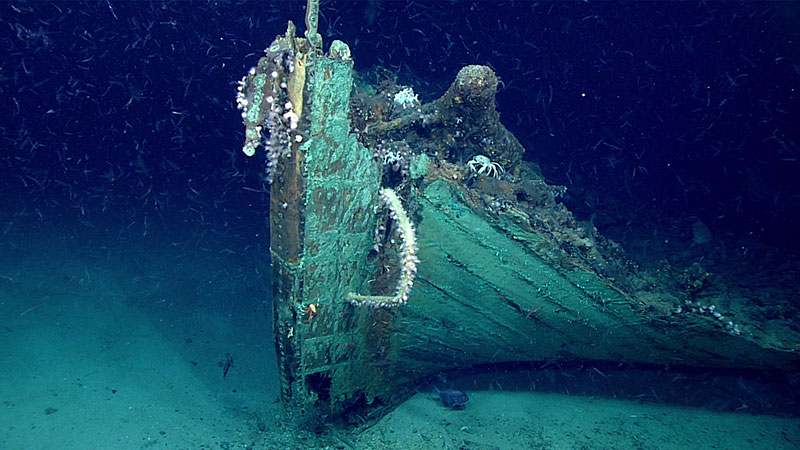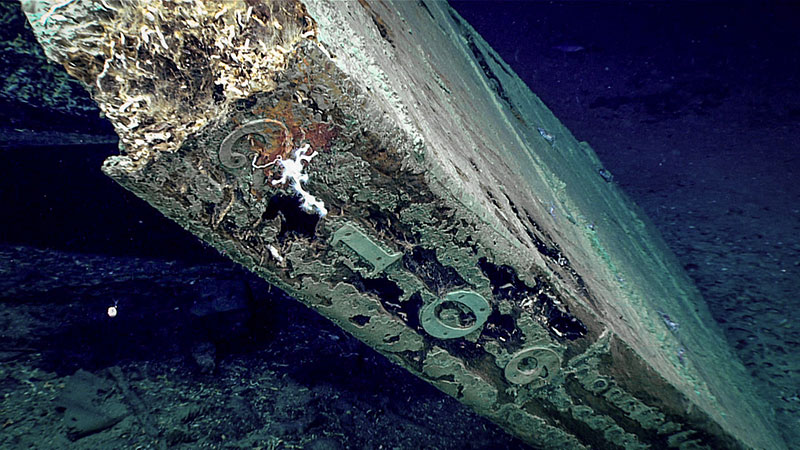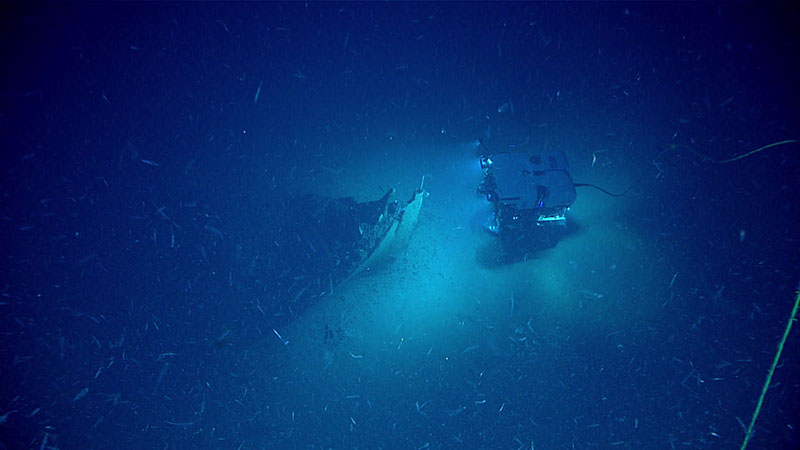
Frank Cantelas, NOAA Office of Ocean Exploration and Research
James Delgado, SEARCH, Inc.
Joe Hoyt, NOAA Office of National Marine Sanctuaries
Jack Irion, Alicia Caporaso, and Scott Sorset, Bureau of Ocean Energy Management
Video courtesy of the NOAA Office of Ocean Exploration and Research. Download larger version (mp4, 63.8 MB).
On May 12, NOAA Ship Okeanos Explorer set sail for a 13-day shakedown and sea-trial expedition in the Gulf of Mexico. On May 16, while conducting an "engineering dive" to test new remotely operated vehicle (ROV) equipment, the team made an unexpected – and exciting – discovery: the wreck of what is likely a mid-19th century wooden sailing vessel.
Much of the May 16 dive was spent conducting tests of new ROV equipment and control interfaces...until ROV Deep Discoverer’s sonar picked up what appeared to be something in the shape of a shipwreck, and the team moved in to investigate.
The primary purpose of this shakedown expedition was to test, calibrate, and integrate equipment and train personnel in order to ensure the collection of high-quality data throughout the remainder of 2019. This differs from other missions on the Okeanos that are focused on exploring specific targets for scientific data collection and discovery. So the shipwreck finding required a swift change in operations, illustrating the power of telepresence technology. After a flurry of phone calls and emails to marine archaeologists around the country, experts tuned in to live video from the seafloor, lending their expertise as they virtually joined the dive. With a cadre of experts watching the dive, the ship’s Commanding Officer and the mission team agreed to extend the dive three hours longer than planned, enabling a more thorough characterization of the wreck.

A low-resolution photomosiac of the wreck site, produced by Bureau of Ocean Energy Management Marine Archaeologist Scott Sorset using video imagery collected during the dive. A higher-resolution version will be developed eventually, providing another tool for studying this shipwreck. Image courtesy of the Bureau of Ocean Energy Management. Download larger version (jpg, 5.7 MB).
High-definition video was recorded by the ROVs as the team systematically explored the wreck site. The video imagery was carefully collected to enable the creation of a complete photomosaic of the wreck site by a specialist onshore, which will allow marine archaeologists and other experts to analyze the findings, collaborate, and make interpretations ex post facto. While interpretations are still forthcoming, marine archaeologists have been able to share some general impressions ascertained from viewing the live stream.
Those who joined the live stream suspect that the wreck is that of a sailing vessel built sometime in the mid-19th century, perhaps a schooner or brig, measuring roughly 37.8 meters (124 feet) long. The vessel is wooden with copper sheathing covering the bottom of its hull. Experts were able to infer the time period of the vessel’s origination based on a number of construction features, including the form of the stem and bow, the body of the hull, and the remains of the windlass. However, this information does not indicate the age of the vessel at the time it was lost, which could have been decades later. Initial observations also noted copper and iron artifacts at the site, but no diagnostic artifacts reflecting the vessel’s rig, trade, nationality, or crew were identified during the dive.

A close-up view of the bow. Marine life is prevalent on the wreck, except on the copper sheathing which still retains its antifouling ability to keep the hull free of marine organism like Teredo navalis (shipworm) that would otherwise burrow into the wood and consume the hull or barnacles that would reduce the vessel’s speed. Image courtesy of the NOAA Office of Ocean Exploration and Research. Download larger version (jpg, 1.3 MB).

The numbers “2109” are visible along the trailing edge of the shipwreck's rudder. The pattern of nails securing the copper sheathing is plainly visible. Image courtesy of the NOAA Office of Ocean Exploration and Research. Download larger version (jpg, 1.6 MB).
The hull remains are more or less intact up to the water line, with its timber protected by the sheathing. Some of the sheathing has deteriorated and fallen off the hull, leaving only the edges of each copper plate where they were tacked or nailed to the hull. However, all structure above the waterline is missing, and during the initial observations of the dive, there did not appear to be many traces of the standing rigging. Furthermore, a number of timbers appeared charred and some of the fasteners were bent, which may be an indication of burning. While the evidence is still being assessed, it is possible that this sailing vessel caught fire and was nearly completely consumed before sinking. This may explain the lack of artifacts from the rigging, decks, and upper works, as well as the lack of personal possessions.

ROV Deep Discoverer approaching the bow of the shipwreck. Image courtesy of the NOAA Office of Ocean Exploration and Research. Download larger version (jpg, 598 KB).
This shakedown mission, which began in Pascagoula, Mississippi, and concluded on May 24 in Key West, Florida, comes after the winter scheduled drydock and dockside shipyard repair period. While underway, 24-hour operations focused on preparing deep-sea mapping and water column sonars and ROV systems for the remainder of 2019 expeditions.
Three “engineering dives,” including the dive during which the shipwreck was discovered, were conducted during the first part of the expedition. The dives allowed members of the Global Foundation for Ocean Exploration to calibrate the ROV’s ultra short baseline (USBL) positioning system, test a new suction sampling device, test on-ship data transfer and telepresence systems, and train new team members. As the dives focused on testing new equipment, no physical samples were collected for later analyses.
Mapping shakedown operations during the expedition included calibrating the ship's EM302 multibeam sonar (used to map the seafloor and water column) and the EK60 split-beam sonar (used to explore the water column); integrating and calibrating a new Simrad EK80 split-beam sonar (for further water column exploration); and installing and testing a new sonar synchronization unit (K-Sync – to reduce potential interference between different sonars).
All of these operations will help ensure the collection of high-quality data throughout the remainder of the year.